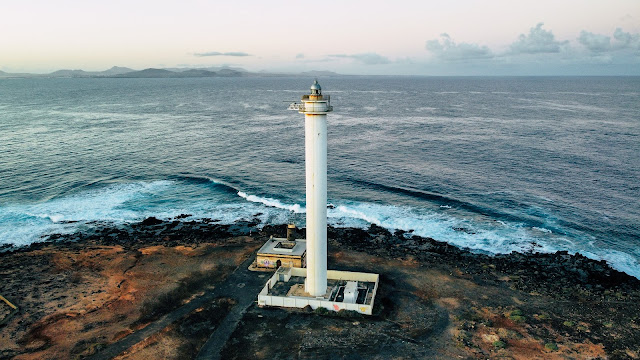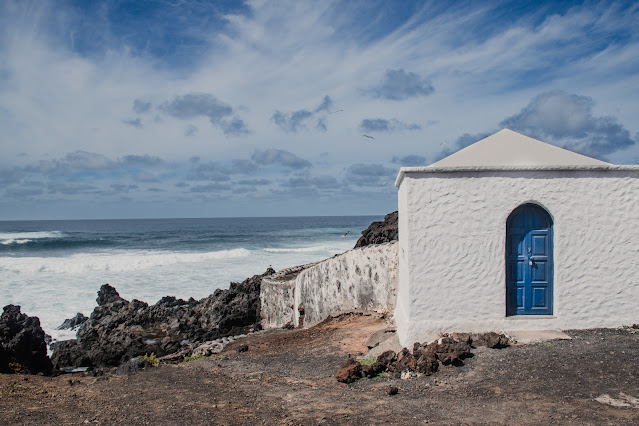High and Dry
I have been wiring this travel blog for nearly six years now and this is the one hundred and first episode I've written. The first blog explaining the concept behind the Postcards from Mancunian is here. And all the reasons for writing this journal (including fun) still ring true 101 blogs and 1000s of lighthouses later.
I've been taking photographs of lighthouses for over fifteen years now. I'd always been a keen amateur photographer, but trip to a nearby lighthouse in Wales to impress my new girlfriend at the time (who had a fondness for lighthouses) made a huge impact on my life in many ways.
 |
Faro de Punta Pechiguera, Lanzarote |
The very purpose of a lighthouse in protecting seafarers against the the most dangerous natural obstacles or providing a guiding light often means they are positioned in the most dramatic and beautiful vantage points. Perfect for a photograph. The courageous, engineered beacon of hope providing a heroic juxtaposition against the forces of Mother Earth to breath-taking effect, or something on those lines.
 | |
|
So one trip to a lighthouse (with camera and new girlfriend) turned into many trips to lighthouses. Subsequent holidays would (within reason) be based around visiting lighthouses. On one trip to Canada we bagged (an accepted Pharology term) nearly 75 lighthouses and was probably my most enjoyable trip away from these shores. France has the most dramatic lighthouses, the East Coast of America the most picturesque. We'll endeavour to find a lighthouse in most of the countries we visit. The pursuit of which cajoles us to explore places, coastlines and islands we would have never previously dreamt of visiting and they all get a mention in this blog.
Oh and my amateur Pharologist girlfriend has been my wife for over eleven years and yes, we did get married in a lighthouse.
| Dawn at Faro de Punta Pechiguera, Lanzarote |
Now, lets get back to travel, and of course lighthouses. This is a short tale of airborne adventures, of man versus nature, of sunrises and crashing waves, of getting up close and of saying goodbye.
Lanzarote over the years become our default wind-down destination. We've explored the island extensively and so feel no pressure to 'see all the sights' in a hectic fashion. But the sights continue to retain their beauty so we can dip into a known pool of treasures and choose where to revisit on each trip. But we will always return to El Golfo and have lunch overlooking the sea.
 |
| El Golfo, Lanzarote |
For those after strictly hardcore Lanzarote travel tips, I do have previous. The first Lanzarote blog documents all the big-hitting must-see's and can be found here
Lanzarote is César Manrique and César Manrique is Lanzarote. His legacy including the extraordinary art installations, buildings and his enhancement of the island's natural wonders are discussed here
As our 'safe' place, we returned to Lanzarote in between the pandemic lock-downs and this blog contains some places of interest that are further afield and a little off the beaten track. Check it out here
As a photographer of lighthouses the limitation is sometimes getting up close to the top of these towering structures. If there is no access to the lantern room, what does the landscape look like from the lighthouse. What does the lighthouse see?
| Sunrise at Faro de Punta Pechiguera, Lanzarote |
The answer to this and the natural progression (or supplementary tool) to any photographer of lighthouses is a drone. Now affordable and no longer in the constraints of licensed pilots. A sub 250-gram drone is small, light, easily fits into luggage and doesn't have to be registered. There are a few online exams to take and you must check each country's rules for usage, but in general it's a straight forward process to get up and flying and taking photos or shooting video.
I had road tested my new DJI Mini SE drone in the USA, but we visited at the times of the dramatic California storms so the weather curtailed any extended usage.
So our trip to Lanzarote was a great excuse to really road test this new piece of kit and put it through it's paces, little did I know it would have such a dramatic ending.
It started off fabulously. We were based, as always in the sedate resort town of Play Blanca in the south west of the island. On the outskirts of town is the towering Faro de Punta Pechiguera. The lighthouse is easily reachable on the great coastal paths that run either side of the the town and is visible for miles around. It was a great place to start filming so it's why on the first day of our holidays I found myself up at the crack of dawn to capture the sunrise.
| Faro de Punta Pechiguera, Lanzarote |
Flying a drone is easy, but capturing those flowing huge landscape shots requires a high level of expertise, so please forgive the sometimes bumpy footage I put together on that morning. But for a lighthouse enthusiast getting that close up, and seeing the top of the lighthouse on it's home turf is incredibly exciting. It does open a whole new world of opportunity. Just be wary of the locals......
 |
| Charco de Los Clicos, El Golfo, Lanzarote |
The career of my first drone came to a dramatic end at the Charco de Los Clicos, or the green lake. A stunning natural phenomena on the beach just south south of El Golfo. It was made famous by Raquel Welch posing on the beach for the promotional shots of the film One Million Years BC (1966). The small lake sits on the beach surrounded by steep black rock cliffs.
And it was on those dramatic cliffs that my drone landed after it suddenly fell from the sky and tumbled down a steep shale incline until it settled, stuck upside down. I wasn't able to recover the aircraft as it was high up on an inaccessible cliff, but I did manage to recover the footage. That's when I discovered the attack on the drone by a bird of prey, not from pilot error as I had originally thought. From the markings it looks like a falcon.
I was left with no option but to mark the resting place of my drone via satellite maps and retreat as the the battery life slowly ebbed away. One-nil to nature. Lesson learnt.
 |
| Drone graveyard at Charco de Los Clicos, Lanzarote |




Bird attack- incredible
ReplyDeleteI thought I'd crashed it. Couldn't believe the footage.
Delete